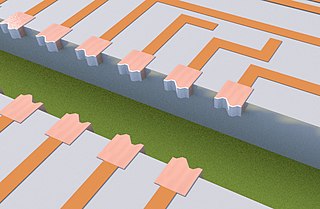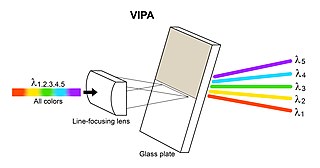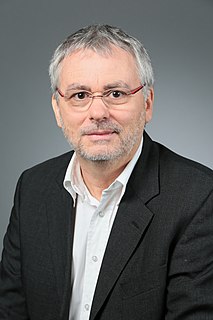Related Research Articles

Interferometry is a technique which uses the interference of superimposed waves to extract information. Interferometry typically uses electromagnetic waves and is an important investigative technique in the fields of astronomy, fiber optics, engineering metrology, optical metrology, oceanography, seismology, spectroscopy, quantum mechanics, nuclear and particle physics, plasma physics, remote sensing, biomolecular interactions, surface profiling, microfluidics, mechanical stress/strain measurement, velocimetry, optometry, and making holograms.

The Mach–Zehnder interferometer is a device used to determine the relative phase shift variations between two collimated beams derived by splitting light from a single source. The interferometer has been used, among other things, to measure phase shifts between the two beams caused by a sample or a change in length of one of the paths. The apparatus is named after the physicists Ludwig Mach and Ludwig Zehnder; Zehnder's proposal in an 1891 article was refined by Mach in an 1892 article. Demonstrations of Mach–Zehnder interferometry with particles other than photons had been demonstrated as well in multiple experiments.
An optical waveguide is a physical structure that guides electromagnetic waves in the optical spectrum. Common types of optical waveguides include optical fiber waveguides, transparent dielectric waveguides made of plastic and glass, liquid light guides, and liquid waveguides.

An optical add-drop multiplexer (OADM) is a device used in wavelength-division multiplexing systems for multiplexing and routing different channels of light into or out of a single mode fiber (SMF). This is a type of optical node, which is generally used for the formation and the construction of optical telecommunications networks. "Add" and "drop" here refer to the capability of the device to add one or more new wavelength channels to an existing multi-wavelength WDM signal, and/or to drop (remove) one or more channels, passing those signals to another network path. An OADM may be considered to be a specific type of optical cross-connect.
Silicon photonics is the study and application of photonic systems which use silicon as an optical medium. The silicon is usually patterned with sub-micrometre precision, into microphotonic components. These operate in the infrared, most commonly at the 1.55 micrometre wavelength used by most fiber optic telecommunication systems. The silicon typically lies on top of a layer of silica in what is known as silicon on insulator (SOI).

Digital planar holography (DPH) is a method for designing and fabricating miniature components for integrated optics. It was invented by Vladimir Yankov and first published in 2003. The essence of the DPH technology is embedding computer designed digital holograms inside a planar waveguide. Light propagates through the plane of the hologram instead of perpendicularly, allowing for a long interaction path. Benefits of a long interaction path have long been used by volume or thick holograms. Planar configuration of the hologram provider for easier access to the embedded diagram aiding in its manufacture.

A slot-waveguide is an optical waveguide that guides strongly confined light in a subwavelength-scale low refractive index region by total internal reflection.

Quilt Packaging (QP) is an integrated circuit packaging and chip-to-chip interconnect packaging technology that utilizes “nodule” structures that extend out horizontally from the edges of microchips to make electrically and mechanically robust chip-to-chip interconnections.
Self-mixing or back-injection laser interferometry is an interferometric technique in which a part of the light reflected by a vibrating target is reflected into the laser cavity, causing a modulation both in amplitude and in frequency of the emitted optical beam. In this way, the laser becomes sensitive to the distance traveled by the reflected beam thus becoming a distance, speed or vibration sensor. The advantage compared to a traditional measurement system is a lower cost thanks to the absence of collimation optics and external photodiodes.

Paul R. Prucnal is an American electrical engineer. He is a professor of electrical engineering at Princeton University. He is best known for his seminal work in Neuromorphic Photonics, optical code division multiple access (OCDMA) and the invention of the terahertz optical asymmetric demultiplexor (TOAD). He is currently a fellow of IEEE, Optical Society of America and National Academy of Inventors.
In physics, a high contrast grating is a single layer near-wavelength grating physical structure where the grating material has a large contrast in index of refraction with its surroundings. The term near-wavelength refers to the grating period, which has a value between one optical wavelength in the grating material and that in its surrounding materials.
Richard Magee Osgood Junior. is an American applied and pure physicist. He is currently Higgins Professor of Electrical Engineering and Applied Physics at Columbia University.
Integrated quantum photonics, uses photonic integrated circuits to control photonic quantum states for applications in quantum technologies. As such, integrated quantum photonics provides a promising approach to the miniaturisation and scaling up of optical quantum circuits. The major application of integrated quantum photonics is Quantum technology:, for example quantum computing, quantum communication, quantum simulation, quantum walks and quantum metrology.
An erbium-doped waveguide amplifier is a type of an optical amplifier. It is a close relative of an EDFA, Erbium-doped fiber amplifier, and in fact EDWA's basic operating principles are identical to those of the EDFA. Both of them can be used to amplify infrared light at wavelengths in optical communication bands between 1500 and 1600 nm. However, whereas an EDFA is made using a free-standing fiber, an EDWA is typically produced on a planar substrate, sometimes in ways that are very similar to the methods used in electronic integrated circuit manufacturing. Therefore, the main advantage of EDWAs over EDFAs lies in their potential to be intimately integrated with other optical components on the same planar substrate and thus making EDFAs unnecessary.

Juerg Leuthold is a full professor at ETH Zurich, Switzerland.

Prof. Ravindra Kumar Sinha is the Vice Chancellor of Gautam Buddha University, Greater Noida, Gautam Budh Nagar Under UP Government. He was the director of the CSIR-Central Scientific Instruments Organisation (CSIR-CSIO) Sector-30C, Chandigarh-160 030, India. He has been a Professor - Applied Physics, Dean-Academic [UG] & Chief Coordinator: TIFAC-Center of Relevance and Excellence in Fiber Optics and Optical Communication, Mission REACH Program, Technology Vision-2020, Govt. of India Delhi Technological University Bawana Road, Delhi-110042, India.

A virtually imaged phased array (VIPA) is an angular dispersive device that, like a prism or a diffraction grating, splits light into its spectral components. It works almost independently of polarization. In contrast to prisms or regular diffraction gratings, it has a much higher angular dispersion but has a smaller free spectral range. This aspect is similar to that of an Echelle grating which is usually used in reflection, since high diffraction orders are also used there. The VIPA can be a compact optical component with high wavelength resolving power.
A multi-mode interferometer (MMI), also known as a multimode interference coupler, is a micro-scale structure in which light waves can travel, such that the optical power is split or combined in a predictable way. In an MMI, light is confined and guided, and thus the MMI is essentially a broad optical waveguide. For example, an ideal 1x2 MMI would be a 50-50 splitter, such that light enters along one path and exits along two paths, with half the power in each exit path. These entrance and exit paths are narrow waveguides, and the MMI itself is in the shape of a broad rectangular box. An ideal 50-50 splitter is nearly impossible in practice, due to the complex behavior of light. Optical loss will always occur as light travels through an MMI, which means that the total output power of a real MMI is less than the total input power. Additionally, the light propagates through the rectangular box in multiple modes, while also experiencing reflection and interference. This leads to mathematical models and equations that are too complex to solve by hand, and thus MMIs are typically designed through computer simulations.

Luc Thévenaz is a Swiss physicist who specializes in fibre optics. He is a professor of physics at EPFL and the head of the Group for Fibre Optics School of Engineering.
References
- ↑ Dainesi, P.; Kung, A.; Chabloz, M.; Lagos, A.; Fluckiger, P.; Ionescu, A.; Fazan, P.; Declerq, M.; Renaud, P. (June 2000). "CMOS compatible fully integrated Mach-Zehnder interferometer in SOI technology". IEEE Photonics Technology Letters. 12 (6): 660–662. Bibcode:2000IPTL...12..660D. doi:10.1109/68.849076. ISSN 1041-1135. S2CID 1309834.
- ↑ Li, X.; Xiao, X.; Xu, H.; Li, Z.; Chu, T.; Yu, J.; Yu, Y. (March 2013). "Highly Efficient Silicon Michelson Interferometer Modulators". IEEE Photonics Technology Letters. 25 (5): 407–409. Bibcode:2013IPTL...25..407L. doi:10.1109/lpt.2013.2238625. ISSN 1041-1135. S2CID 23495473.
- ↑ Koshelev, A.; Calafiore, G.; Peroz, C.; Dhuey, S.; Cabrini, S.; Sasorov, P.; Goltsov, A.; Yankov, V. (2014-10-01). "Combination of a spectrometer-on-chip and an array of Young's interferometers for laser spectrum monitoring". Optics Letters. 39 (19): 5645–5648. Bibcode:2014OptL...39.5645K. doi:10.1364/ol.39.005645. ISSN 1539-4794. PMID 25360949.
- ↑ Arrayed-Waveguide Grating Multi/Demultiplexer, NTT Electronics Corporation
- ↑ Planar Lightwave Circuits Enable Next-Generation 40G/100G Networks, Photonics Spectra magazine, March 2010